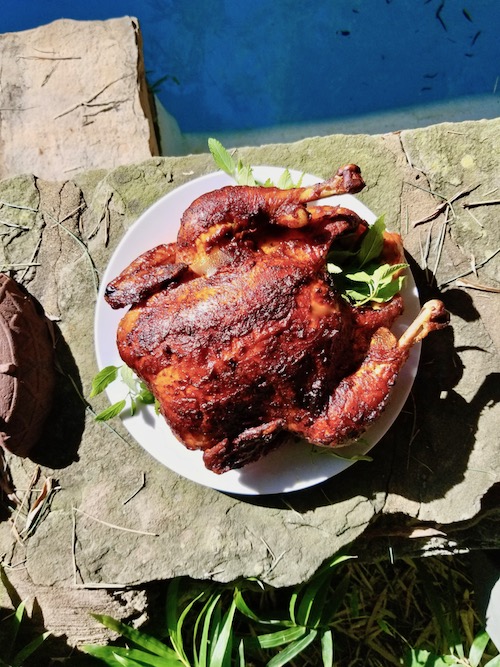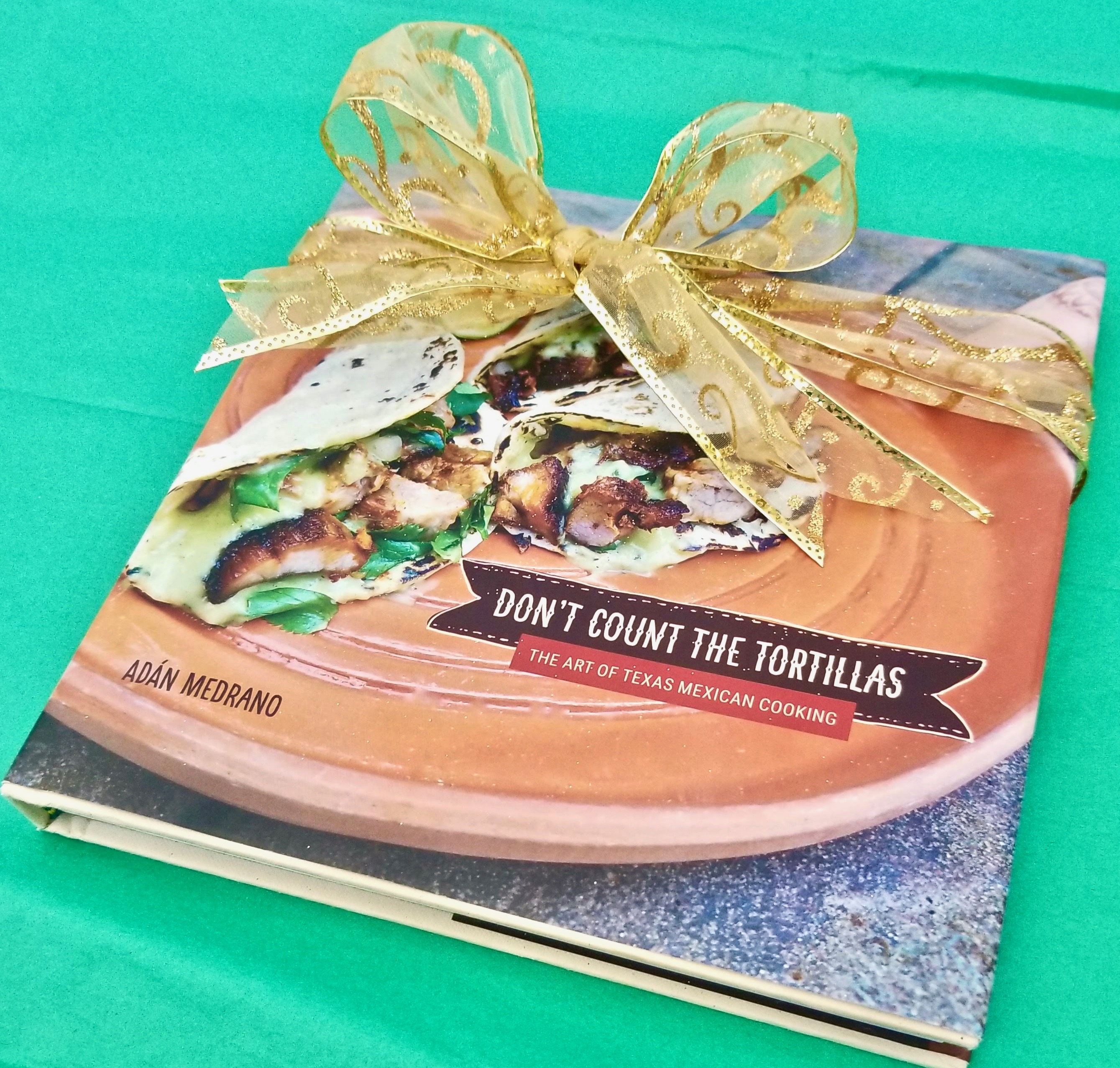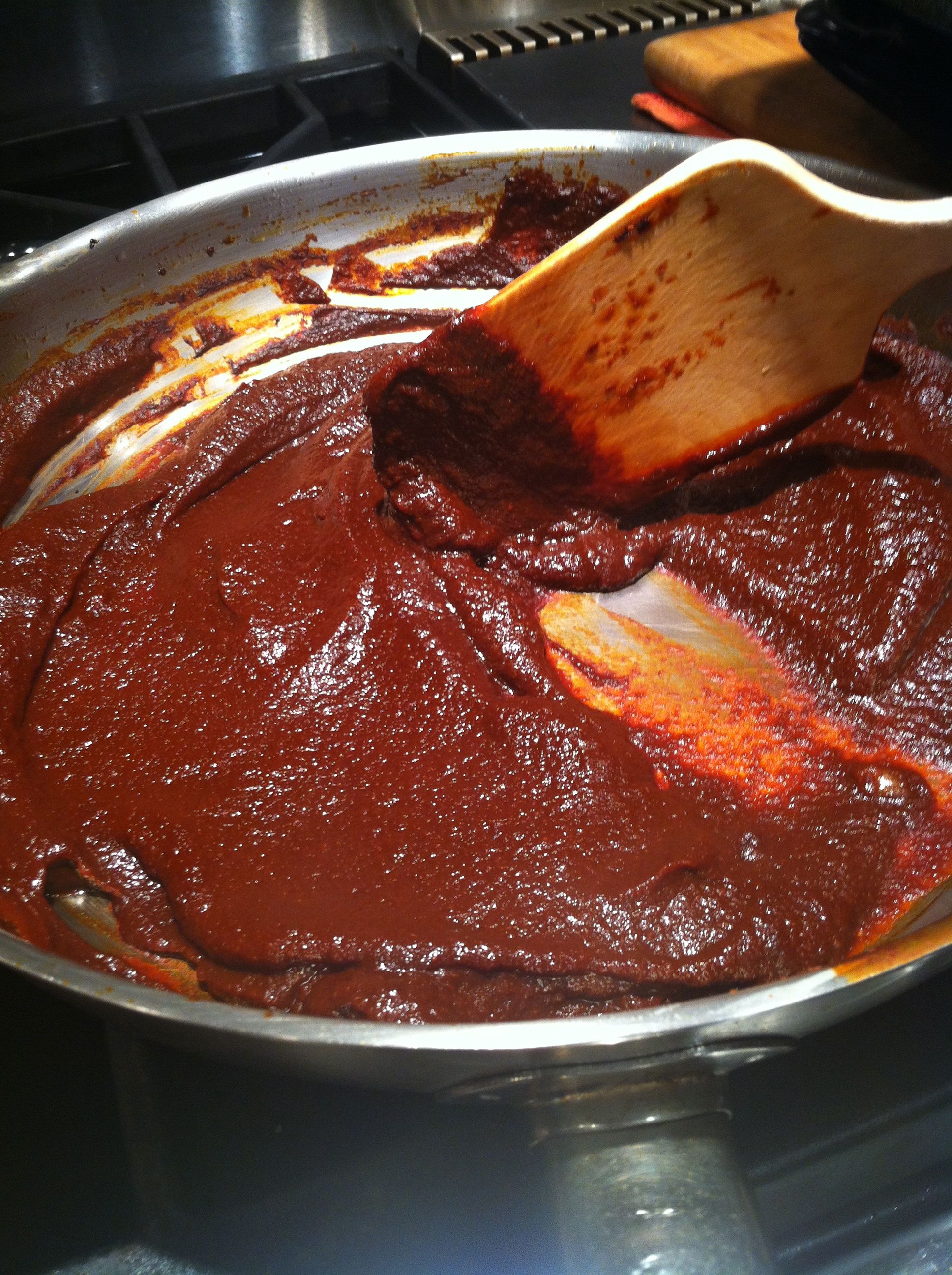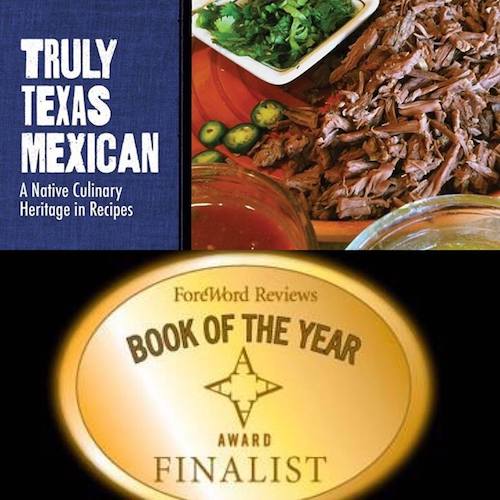Turkey Enchilado – A Mexican Thanksgiving

A delicious Mexican favorite, this recipe for Turkey Enchilado, or Guajolote Enchilado, will bring mouthwatering smiles to your family and amigos, amigas. I use only one type of chile, Chile Ancho, because I like the direct flavor and also because this is the dried chile that my mom used most often during the holidays.
Please leave me a comment on how you like it if you decide to try this new Turkey Enchilado. Start thawing the turkey now because you’ll brine it for 3 days, which makes it really tender and flavorful. Rubbing or marinating a turkey with chile is a southern Mexican tradition in some families, and to me it’s also a celebratory nod to indigenous, Native American roots here in Texas and Northeastern Mexico.
Holiday Gift Cookbook!
 “Don’t Count The Tortillas: The Art Of Texas Mexican Cooking”
“Don’t Count The Tortillas: The Art Of Texas Mexican Cooking”
Over 100 kitchen-tested recipes: Tacos Al Pastor; Red Enchiladas; Tortilla Soup; Nopalitos Salad;
Also Vegan dishes and traditional Mexican pastries and cookies like Marranitos!
There’s even a Chile Con Queso Soufflé and yummy Mesquite Candy Balls! Easy step-by-step guide.
Appetizers, Cocktails and Desserts. Illustrated with gorgeous pictures, written with history and humor.
ORDER NOW
Europeans who started coming to Texas in the 1500s found that wild turkeys were indeed a food source in the various communities.
Not many people know that the Karankawa, Coahuiltecan, Lipan, Tonkawa and other peoples living in Texas this past millenia traded with the communities in southern Mexico. Actually, places like Houston, San Antonio and others were quite cosmopolitan, in the sense of having wide international sophistication.
Dr. Alston Thoms, Professor of Anthropology at Texas A&M University explains that the Gulf Coastal Plains, including Houston and vicinity, were the center of constant communication, with trade fairs that drew people from as far west as the hill country, and lasted for a couple of weeks. San Antonio had heavily traveled routes leading into central and southern Mexico and these routes were later used by the Spaniards and they called them El Camino Real.
Descendants of Native Americans like the Coahuiltecan, Jumano, along with Karankawa, Lipan, Tonkawa and others, continued to live all across Texas. But they did so as “Mexicans” because their Native American identities were erased by the Republic of Texas. Their name was officially changed to “Mexican” in 1837 by the Texas Standing Committee On Indian Affairs in its report to then President Sam Houston:
“The People called Lipan, Karankawa and Tonkawa your Committee considers as part of the Mexican nation and no longer to be considered as a different People.”
Suddenly, Texas Native Americans were morphed into Mexicans. Although Texas indigenous peoples were thereafter recognized only as Mexican, we nevertheless continued cooking and that’s how we keep alive the native roots of today’s Texas Mexican food.
The knowledge that we are Native American has always been present, and now more Mexican Americans are beginning to claim their indigenous identity. According to the 2010 US Census, after the Navajo people the next largest group of Native Americans to self identify as a tribal group is “Mexican American Indian.” The tribal grouping information in the table below quantifies that Mexican Americans continue to ratify their indigenous, Native American, “Indian,” identity.
 About indigenous cooking there is a philosophy I learned from my apá and amá, from the way they lived, I follow it. On any land that we stand, anytime we cook we get the chance to welcome all, everybody, no matter what race, ethnicity, gender, sexual orientation or religion. In the larger sense, indigenous means that all human beings are of this earth, bound up together as brothers and sisters in community. Let’s celebrate that fact this Thanksgiving, (false pilgrim myths aside), at a table where all are welcome.
About indigenous cooking there is a philosophy I learned from my apá and amá, from the way they lived, I follow it. On any land that we stand, anytime we cook we get the chance to welcome all, everybody, no matter what race, ethnicity, gender, sexual orientation or religion. In the larger sense, indigenous means that all human beings are of this earth, bound up together as brothers and sisters in community. Let’s celebrate that fact this Thanksgiving, (false pilgrim myths aside), at a table where all are welcome.
Recipe for Turkey Enchilado
Ingredients
1 Twelve-pound turkey (completely thawed if previously frozen)
For the chile ancho paste:
5 oz. chiles anchos, about 9 large
10 garlic cloves
1 cup chopped white or yellow onion
1 cup water
2/3 cup olive oil
For the giblet stock:
Neck and giblets from a 12-lb turkey
6 cups water
For the brine:
2 gallons warm water
6 oz. piloncillo (Mexican unrefined brown sugar)
11 oz. salt
2 cups chile ancho paste from above recipe

Aromatics to stuff the turkey:
10 five-inch sprigs of fresh Mexican oregano (Lippia Graveolens), or 2 Tbs dried
4 cloves garlic
1 medium orange, washed, unpeeled, quartered
1⁄2 small white or yellow onion
For the chile ancho adobo:
2 cups diced fresh or canned tomatoes
2 Tbs fresh Mexican oregano (Lippia Graveolens) or 1 tsp. dried
2 cups turkey giblet stock
2/3 cups chile ancho paste from above
1 tsp. salt
1/8 tsp. sugar
Method
To make the chile ancho paste (makes 4 cups):
1. With a paring knife or scissors, cut a slit lengthwise on each chile ancho, then open each pod and remove the stem, all the seeds and the membranes.
2. Place the de-seeded chiles in a pot of boiling water, turn off the heat, cover and let stand for 25 minutes, until the chiles are rehydrated and thoroughly soft.
3. Drain the rehydrated chiles and place them in a blender, along with the garlic cloves and the onion. Add 1 cup clean water and blend on high until there are no particles and the purée is smooth and velvety, about 45 seconds and up to 1 1⁄2 minutes.
4. Heat 1 Tbs of the olive oil in a large saucepan over medium heat, then pour in the blended chile purée and cook for 10 minutes, stirring occasionally, until the color deepens and the purée thickens slightly into a paste. Be careful, as the mixture will cause splatter and you may need to partially cover it.
5. Turn off the heat, add the remaining olive oil and whisk to combine thoroughly. Measure to make sure there are 4 cups of paste, adding a small amount of water as needed. Set aside.
To brine the turkey 3 days before it is to be roasted:
1. In a large non-corrosive container such as glass, enamel, plastic or stainless steel, mix all the brine ingredients so that the salt and piloncillo are completely dissolved.
2. Remove the neck and giblets from the turkey. Submerge the turkey in the brine so that it is completely covered, and refrigerate for 3 days.
To make the giblet stock:
1. In a large saucepan, add the neck, giblets, 6 cups of water and bring to a boil.
Lower the heat and simmer gently, partially covered, for 3 hours, skimming and discarding the foam that forms on the surface. The liquid will reduce to about 3 cups. Set aside to cool, and then refrigerate until needed to make the chile ancho adobo, below.
To roast the chile ancho turkey
1. Remove the turkey from the brine and pat it dry. Place in a roasting pan and let it stand at room temperature for 45 minutes.
2. Pre-heat oven to 325°F.
3. In a wide-mouth bowl, pour 1 cup of the remaining chile ancho paste, to use for basting the turkey. Apply a thin coating of chile paste over the entire turkey.
4. Stuff the turkey with the Mexican oregano, garlic cloves, onion and quartered orange.
Place the turkey in the 325º F oven and roast for a total of about 4 hours, until the internal temperature reaches 165º F.
5. After the first hour, remove the turkey from the oven and baste it with the fat drippings, then brush a second thin layer of the chile paste all over. Do this also after the third hour.
6. When the turkey reaches an internal temperature of 165º F, remove it from the oven and let it rest for 30 minutes. Remove the aromatics from the cavity and discard.
To make the chile ancho adobo
1. In a blender, place the tomatoes and oregano and blend on high until there are no large oregano flakes, about 30 seconds.
2. In a saucepan, over medium heat, add the tomato and oregano mixture, along with 2 cups of the giblet stock, plus the salt and sugar. Bring to a simmer and cook gently for 30 minutes. The adobo will thicken slightly.
Set aside and keep warm until ready to serve.
I suggest you serve it with Cornbread Dressing and Brussels Sprouts With Serrano and Pecan. I wish you and all your loved ones a happy Thanksgiving day!
A Holiday Gift Cookbook!
Click here to buy my award-winning cookbook, “Truly Texas Mexican: A Native Culinary Heritage In Recipes.”
Over 100 kitchen-tested recipes of the most delicious traditional dishes like: Barbacoa, Cilantro Rice, Huevos Rancheros, Tostadas, Tamales, Cheese Enchiladas and many more. Margaritas, Cocktails, Appetizers and Desserts. Gorgeous photographs and step-by-step instructions.

Hi, this recipe has been on my mind ever since I read it last fall, and I finally had a chance to try it this summer. A couple of things I was wondering about and some thoughts on the flavor:
1. Cooking this in the summertime meant that whole turkeys available to me aren’t the larger ones usually in stores at Thanksgiving. I knew better than to cook my 8 lb turkey for 4 hours, but others may not. Adjusting the cooking timing to reference time as a function of weight might be helpful.
2. When I have made chili paste I’ve typically run the softened chilis through a mill to separate the skins, as I don’t like the slightly bitter flavor they can give to the paste. I didn’t do that here but probably will next time. This is obviously my personal preference, but curious if there’s another technique to preparing dried chilis that can mellow that flavor element.
3. I got a bit crunched for time and ended up leaving the turkey in the brine an extra day – and the result was unsurprisingly quite salty. This was probably also a function of my smallish bird, but for anyone that might be tempted, follow the recipe!
4. I’m curious if you think the cooking could be done on an open fire or in a smoker? I’m already planning to apply the techniques to a smoked turkey, but am thinking this entire recipe could simply be moved into a smoker, if not for the entire cook then at least for parts of the cook.
Anyway, I really appreciate this recipe, and expect I’ll practice it a few more times before putting on my table this Thanksgiving! Thank you for sharing these recipes and the stories of Texas Mexican cooking, both here and in your books, which I enjoy very much (both the reading and the eating!)
Just reading your recipe makes me hungry! It’s too late for this year but we’ll try it next year for sure, and in the meantime I’ll ask for one of your cookbooks for Christmas. I grew up in the Northeast, but my Dad was a Brownsville, TX native who taught all of us to love Mexican food. Thanks, and have a great holiday season with your famili!